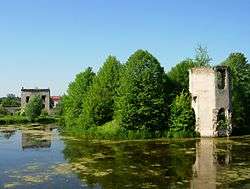Ćmielów
Ćmielów [ˈt͡ɕmʲɛluf] (![]()
Ćmielów | |
|---|---|
 Ruins of Ćmielów Castle | |
 Coat of arms | |
 Ćmielów | |
| Coordinates: 50°53′25″N 21°30′53″E | |
| Country | |
| Voivodeship | Świętokrzyskie |
| County | Ostrowiec |
| Gmina | Ćmielów |
| Area | |
| • Total | 13.21 km2 (5.10 sq mi) |
| Population (2006) | |
| • Total | 3,172 |
| • Density | 240/km2 (620/sq mi) |
| Postal code | 27–440 |
| Area code(s) | +48 41 |
| Car plates | TOS |
| Website | http://www.cmielow.pl/ |
History
First mention of the village comes from the 14th century. In 1388, brothers Marcin and Mikołaj from Baruchów sold the village and the castle to knight Gniewosz of Dalewice. In 1425 Ćmielów was bought by Jan of Podłodów, then the village was acquired by the noble Szydłowiecki family. At that time what today is Ćmielów was divided into two villages - Ćmielów itself, located in the vicinity of the castle, and nearby Szydłów. Both villages were merged in 1505, when in Radom, King Alexander granted town charter to the town of Ćmielów. The new town remained in the hands of the Szydłowiecki family, which turned it into one of their residences. Chancellor Krzysztof Szydłowiecki invested in the castle, making it a Renaissance palace (1519-1531). In 1606, Ćmielów passed into the hands of the Ostrogski family.
Wartime experience
Prosperity of the town came to an end during the Swedish invasion of Poland. On April 12, 1657, Swedish and Transylvanian armies met here, and the castle was the temporary residence of George II Rakoczi. United armies of the two powers destroyed most of Lesser Poland, together with Ćmielów. In the 18th century the town belonged to several families (Lubomirski family, Małachowski family, Pusłowski family), and in 1896 - to Prince Aleksander Drucki-Lubecki. Some time in the 18th century Ćmielów emerged as a center of pottery. In 1750, King Augustus III of Poland issued a privilege to local artisans, allowing them to sell their products across the country. The privilege was confirmed in 1768, and either in 1804 or 1809, Count Jacek Małachowski opened here a porcelain factory. Following other towns of northern Lesser Poland, Ćmielów, which after the Partitions of Poland belonged to Russian-controlled Congress Poland lost its town charter in 1869, as a punishment for the January Uprising. In 1915 it received a rail station, along a route from Skarżysko-Kamienna to Sandomierz.
When the Germans occuped Ćmielów in September 1939, they began immediately to rob and starve the Jewish community. In June 1942, the Nazi Germans set up a Jewish ghetto in Ćmielów for about 1,500–2,000 Polish Jews, including all of Ćmielów's 500 Jews. Conditions worsened through hunger, overcrowding, and a typhus epidemic. In late October, 1942, some younger Jews were sent to labor camps, other Jews were murdered in the town, and some 900 Jews were sent to Treblinka killing camp where they were immediately murdered by gassing.[1][2]
Few of the Jewish community survived; after the war 16 Jews registered in the town but none stayed. [3] Ćmielów regained its town charter in 1962. Among points of interest are the ruins of the castle, parish church (first built in the late 14th century), roadside chapel (1850s), and the St. Florian figure.
External sources
- "Ćmielów – Historia," Muzeum Historii Żydów Polskich Wirtualny Sztetl (Museum of the History of the Polish Jews). Accessed July 6, 2011.
- Megargee, Geoffrey (2012). Encyclopedia of Camps and Ghettos. Bloomington, Indiana: University of Indiana Press. p. Volume II 213-214. ISBN 978-0-253-35599-7.
- Dobroszycki, Lucjan (1994). Survivors of the Holocaust. Armonk, NY: M.E. Sharpe. p. 70. ISBN 1-56324-463-2.
![]()